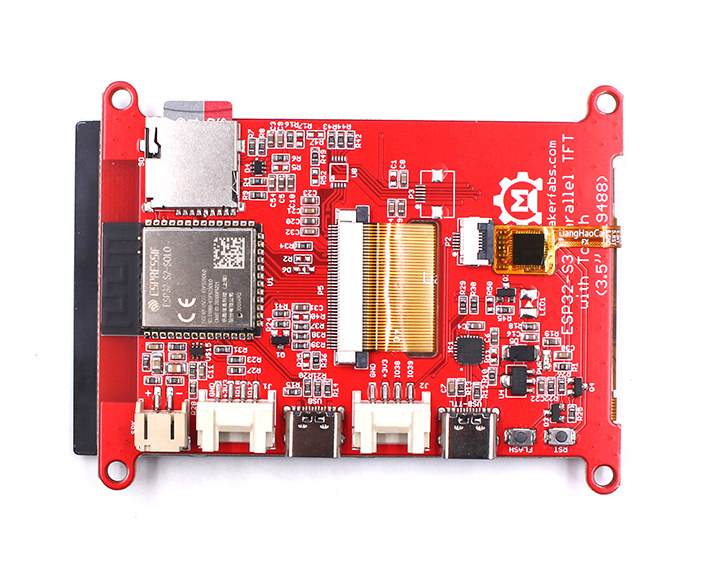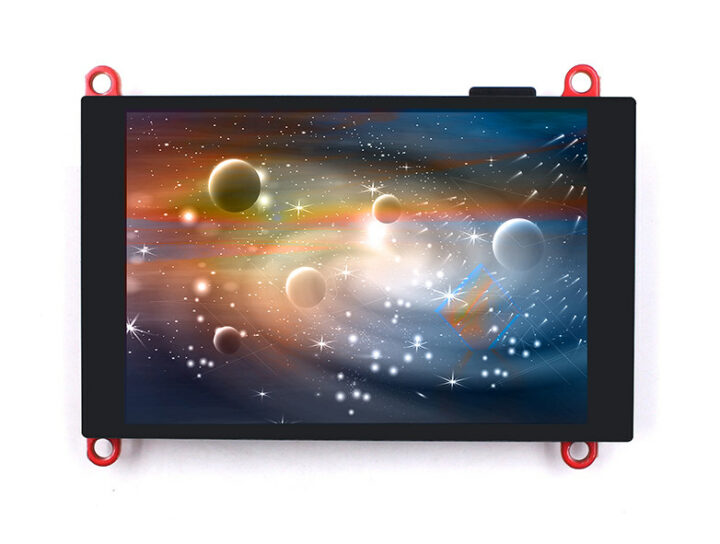Makerfabs has launched a 3.5-inch TFT touchscreen display with built-in WiFi and Bluetooth connectivity through an ESP32-S3 dual-core Tensilica LX7 microcontroller clocked at 240 MHz with vector instructions for AI acceleration.
This display offers a 320×480 resolution through the ILI9488 LCD driver, uses a 16-bit parallel interface for communication with ESP32-S3 clocked at up to 20 Mhz making it suitable for smooth graphics user interface, and the company also claims it is smooth enough for video displays, but more on that later.
Specifications:
- Wireless module – ESP32-S3-WROOM-1-N16R2 with
- Espressif Systems ESP32-S3 dual-core Tensilica LX7 @ up to 240 MHz with vector instructions for AI acceleration, 512KB RAM, 2.4 GHz WiFi 4 and Bluetooth 5.0 LE with support for long-range, up to 2Mbps data rate, mesh networking
- 16MB QSPI flash
- 2MB PSRAM
- PCB antenna
- Storage – MicroSD card socket
- Display – 3.5-inch color TFT LCD with 480×320 resolution, 16-bit parallel interface (ILI94988 driver), and capacitive touch panel (FT6263); backlight controller
- USB – 2x USB Type-C ports, one for USB-to-UART and one for native USB
- Expansion – Mabee interface with 1x I2C, 1x GPIO to add sensors or actuators
- Misc – Flash and Reset buttons
- Power Supply – 5V via USB Type-C port
- Dimensions – 84.3 x 66 x 12mm
- Weight – 52 grams
- Temperature – -40°C to +85°C

The display can be programmed with the Arduino IDE. Sample code using the LovyanGFX library and EAGLE schematics and PCB layout can be found on Github. Makerfabs also designed an ESP32-S2 model that lacks Bluetooth connectivity, and the ESP32-S3 touchscreen display comes with more RAM and eMMC flash.
I was tipped about this display by Jon, a regular reader and commenter on CNX Software, who bought it, and said it works as advertised. The ESP32-S3 can really drive a high-speed display with a parallel LCD interface. However, it can’t stream video because there is no H.264 decoder, but it is great if you want a responsive GUI.
Makerfabs ESP32-S3 16-bit parallel capacitive touchscreen display is sold for $39.80 plus shipping, and the ESP32-S2 model is the same price with a resistive display, and there’s a capacitive display option for $4 more. As a side note, we previously wrote about another, smaller ESP32-S3 display, namely the LilyGO T-Display-S3, with a 1.9-inch display connected over a slower 8-bit parallel interface, and no touchscreen function that sells for around $17.
Thanks to Jon for the tip.

Jean-Luc started CNX Software in 2010 as a part-time endeavor, before quitting his job as a software engineering manager, and starting to write daily news, and reviews full time later in 2011.
Support CNX Software! Donate via cryptocurrencies, become a Patron on Patreon, or purchase goods on Amazon or Aliexpress





